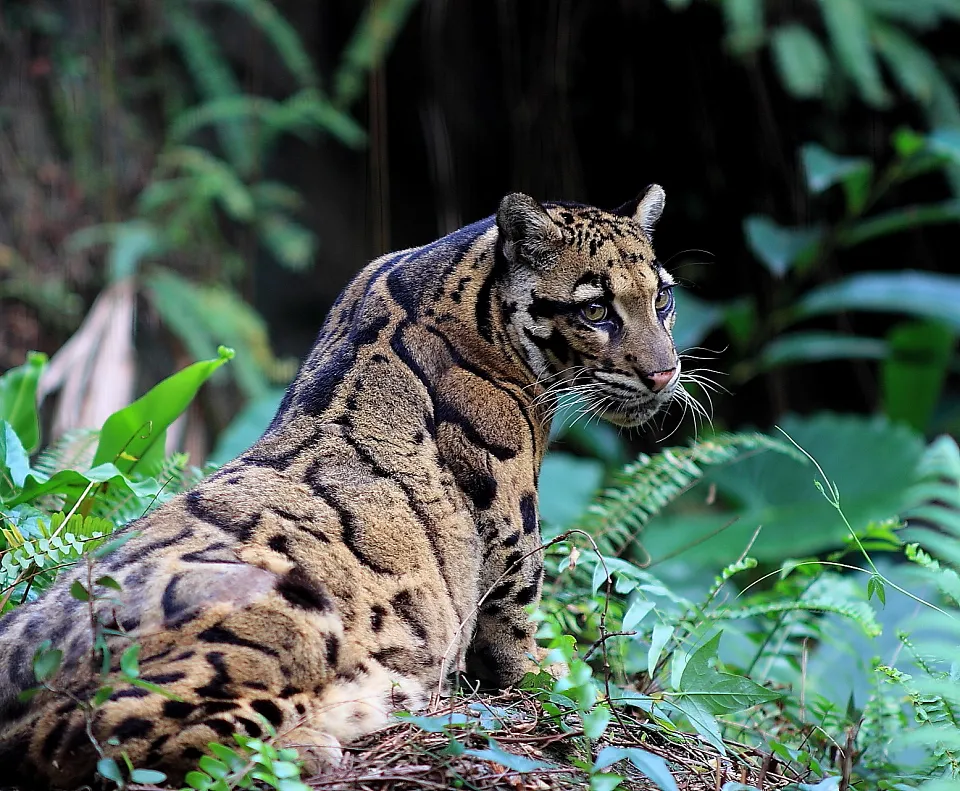Clouded Leopard: The Elusive ghost of Nepal

Kathmandu.Globally, there are approximately 33 species classified as small felids and six as large felids. Compared to their larger counterparts, small felids have historically received less research attention and are consequently less understood in terms of ecology, behaviour, and conservation needs.
Nepal harbours a remarkable felid diversity, encompassing ten small and three large cat species, totalling 13, which positions the country as the second most felid-rich nation globally. Among these species, the clouded leopard (Neofelis nebulosa) is a particularly charismatic and elusive taxon. Classified as Vulnerable by the International Union for Conservation of Nature (IUCN), this species faces significant population declines and, therefore, requires urgent conservation interventions.
1)Mainland clouded leopard (Neofelis nebulosa)
2)Sunda clouded leopard (Neofelis diardii)
The mainland clouded leopard, also called ध्वासे चितुवा in Nepali, is a secretive, lonely, arboreal wild cat that can be found in eastern Nepal’s Terai region and up to the border between Nepal and China.
On the occasion of International Clouded Leopard Day, this article emphasizes the need of studying and protecting clouded leopards and other small cat species.
Morphology
The mainland clouded leopard (Neofelis nebulosa) is a medium-sized cat that weighs between 13.5 kg and 18 kg. It has distinctive dark markings on its body, including blotches, clouds, and black-edged ellipses as well as occasional black spots. Its legs are relatively short in relation to its body, which is 80–90 cm long, and its tail, which is ringed in black, is equally long. Because of their unusual cranial morphology and biggest tooth-to-body ratio, Nebulosa is also known as the “sabre-tooth” of the modern era. Because of the curvature of their skulls, they are often referred to as “tapering headed cats.”
Distribution
The mainland clouded leopard (Nebulosa nebulosa) is found in the following nations: Myanmar, Laos, China, Nepal, India, Bhutan, Malaya, Thailand, and Laos. They are mostly found in carefully maintained protected areas that are shielded from habitat degradation.This species can be found throughout Nepal, from the Terai to the border with Tibet. It has been documented in a number of protected areas, including the Annapurna Conservation Area, the Langtang National Park, the Parsa National Park, the Kanchanjunga Conservation Area, the Shivapuri National Park, the Gosaikunda Lake Area, the Khotang, the Ilam, and the Sikless.The highest point in Nepal is 3,498 meters above sea level, and that is in the Langtang region.
Nutrition
The mainland clouded leopard (Neofelis nebulosa) has never had its diet determined, so it is unknown what its preferred prey is. However, a scat DNA survey conducted in various countries has confirmed that its main sources of food are wild pigs (33% of biomass consumed), small rodents (15%), mainland serrows (13%) and Hog deer (A. porcinus), barking deer (Munjatac spp.), and whole deer.
Procreation
In the case of the mainland clouded leopard (Nebulosa), the male and female prepare for procreation over a period of 26 months.Females go through a 30-day oestrous cycle, and they typically reproduce between the months of March and December, mating numerous times over the course of several days.The mainland clouded leopard (Nebulosa) gives birth to one to five cubs within a single clutch during its 93-day gestation cycle.
Status of Conservation
The mainland clouded leopard (Nebulosa) is classified as a vulnerable species in both the CITIES Appendix I and the IUCN Redlist Data Book. The National Park and Wildlife Conservation (NPWC) Act 1973 of Nepal also provides protection for it.
Ecological function
As a predator and defender of a thriving ecology, the mainland clouded leopard is vital to the ecosystem. It is sometimes referred to as “friends of farmers” since it controls the populations of animals like deer, wild boar, monkeys, and birds that have an impact on farmers. Being an intense arboreal predator, it is a hardship for the farmers and plays a crucial role in maintaining monkey populations in the highlands of Nepal.
Threats
Problems to the mainland clouded leopard include habitat loss, poaching, defragmentation, and the illegal wildlife trade. These problems are ongoing.The world’s fastest rate of deforestation is occurring in the tropical parts of South Asia, which are mostly favourable to its habitat. This is being caused by lack of knowledge and future infrastructure development. The pelt of the mainland clouded leopard is in high demand on the market, and its teeth and bones have extremely high therapeutic potential. Main risks include hydropower projects and country roads in its habitat. In addition, incorrect mating in the wild has occasionally been observed, which may have an impact on the population.
Conservation-focused actions
Due to data scarcity and poaching, mainland clouded leopard conservation has always been difficult. Nevertheless, organizations such as the Clouded Leopard Working Group, Protected Area Authorities, numerous stakeholders, and local communities—from higher to lower levels—are working to keep the species alive. The establishment of an anti-poaching unit in cooperation with the local community, habitat monitoring for clouded leopards, forest fire prevention, and several global initiatives such as awareness campaigns, workshops, and meetings held in close proximity to the mainland clouded leopard’s habitat are just a few examples.
The next step
Despite the growing recognition of the global biodiversity crisis, small felid species continue to be underserved in terms of research, conservation funding, and implementation. Of the 33 recognized small cat species, 13 of the world’s 18 most-threatened wildcat species are small cat, yet comprehensive ecological studies remain scarce. Given the proximity of many small felid habitats to human populations, public awareness and engagement are critical components of effective conservation strategies. Collaborative partnerships with local communities should be prioritized to ensure long-term conservation success. To address these challenges, it is recommended that the Nepali government implement targeted action plans for small felids, utilizing the charismatic clouded leopard as an umbrella species to facilitate broader conservation efforts and secure multi-level governmental support.








 सरकार र शिक्षकहरुबीच सहमति
सरकार र शिक्षकहरुबीच सहमति अमेरिकी अर्थतन्त्र अप्रत्यासित रुपमा सङ्कुचित
अमेरिकी अर्थतन्त्र अप्रत्यासित रुपमा सङ्कुचित बोलेर नभइ कामले नतिजा देखाउनुपर्छ : उपप्रधानमन्त्री सिंह
बोलेर नभइ कामले नतिजा देखाउनुपर्छ : उपप्रधानमन्त्री सिंह दृष्टिविहीन छात्र छात्रवासमै मृत फेला
दृष्टिविहीन छात्र छात्रवासमै मृत फेला आर्थिक वृद्धिदर ४.६१ प्रतिशत, अर्थतन्त्रको आकार ६१ खर्ब सात अर्ब
आर्थिक वृद्धिदर ४.६१ प्रतिशत, अर्थतन्त्रको आकार ६१ खर्ब सात अर्ब शिक्षक साथीहरू ! खल्तीमा सलाईको बट्टा बोकेर हिँड्नेसँग जोगिनुस् : प्रदीप ज्ञवाली
शिक्षक साथीहरू ! खल्तीमा सलाईको बट्टा बोकेर हिँड्नेसँग जोगिनुस् : प्रदीप ज्ञवाली आज वैशाख १५ गते सोमबार ? हेरौं राशिफल
आज वैशाख १५ गते सोमबार ? हेरौं राशिफल काठमाडौं भ्युटावर औचित्यहीन, भत्काउनु उपयुक्त : सुनिता डंगोल
काठमाडौं भ्युटावर औचित्यहीन, भत्काउनु उपयुक्त : सुनिता डंगोल लिभरपुलको कीर्तिमानी : २० औं पटक जित्यो प्रिमियर सिपको उपाधि
लिभरपुलको कीर्तिमानी : २० औं पटक जित्यो प्रिमियर सिपको उपाधि पाकिस्तानले भन्यो, ‘भारतको इशारामा आतंक मच्याउने मारिए ७१ जना आतंककारी’
पाकिस्तानले भन्यो, ‘भारतको इशारामा आतंक मच्याउने मारिए ७१ जना आतंककारी’
प्रतिक्रिया